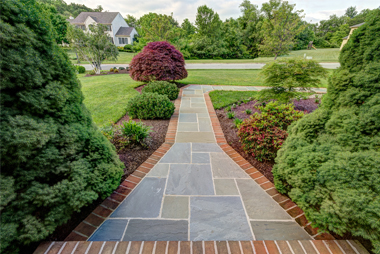Does your property need a little bit of extra love? If your home lacks curb appeal or you just want to add a touch of elegance, consider installing a brick walkway. Not only will it add beauty to your home, but a brick walkway can also increase your property value.
If you’re thinking about adding a brick walkway to your home, this article is a great starting point for learning about this popular home improvement project. We’ll cover the basics of brick walkways, including material options, installation tips, and maintenance considerations.
What is a Brick Walkway?
A brick walkway is a path made of bricks that can be used to lead visitors to your front door or as a garden path. Brick walkways are also commonly used to create patio areas or seating areas in the yard.
Brick walkways can be installed in a variety of patterns and designs so that you can get creative with your project. One popular option is the herringbone pattern, which gives your walkway a classic look.
Another thing to consider when planning your brick walkway is the type of edging you’ll use. Brick borders or concrete edging can help give your project a professional look.
Material Options for Brick Walkways
There are two main types of bricks used for walkways: pavers and standard bricks. Pavers are bricks that have been designed specifically for use in walkways and other paving projects. They’re usually made of concrete or stone and come in a variety of sizes, shapes, and colors.
Standard bricks are the type of bricks you typically think of when you think of construction projects. They’re made of clay and fired in a kiln. Standard bricks can be used for your walkway, but they’re not as durable as pavers and may not last as long. If you choose to use standard bricks for your project, make sure to select bricks that are rated for outdoor use.
Installation Tips for Brick Walkways
Installing a brick walkway is a fairly straightforward process, but there are a few things to keep in mind to ensure a successful project.
First, you’ll need to determine the size and shape of your walkway. Once you know the dimensions of your project, you can calculate the number of bricks you’ll need. It’s always best to buy a few extra bricks just in case you make a mistake or need to replace a damaged brick.
Next, you’ll need to prepare the area where your walkway will be installed. This step is important because it will help ensure that your walkway is level and stable. First, mark the perimeter of your walkway with stakes and string. Then, excavate the area within the perimeter to be about four inches deep.
Once the area is excavated, add a layer of gravel to the bottom of the hole. This will help with drainage and prevent your bricks from shifting. Then, add a layer of sand on top of the gravel and use a level to make sure it’s evenly distributed.
Now you’re ready to start laying your bricks. Begin at one end of your walkway and work your way towards the other. To keep your bricks in place, use a generous amount of mortar between each brick. Be sure to wipe away any excess mortar before it dries.
As you lay each brick, be sure to check that it’s level with the others. Once all of your bricks are in place, allow the mortar to dry for 24 hours before walking on your new walkway.
Consider a Professional Installation
Building on the previous section, it’s clear that installing a brick walkway is an intense and detailed process that takes a fair amount of time, effort, and skill to complete. If you’re not confident in your ability to install a brick walkway, it’s always best to hire a professional contractor.
A professional contractor will have the experience and expertise necessary to install your brick walkway correctly. They’ll also be able to help you select the right materials for your project and offer advice on design options.
Maintenance Considerations for Brick Walkways
Once your brick walkway is installed, it’s important to take care of it so that it will last for many years. One of the best ways to protect your investment is to seal your brick walkway every two or three years. This will help prevent staining and fading.
Another way to keep your brick walkway in good condition is to sweep it regularly and remove any debris, such as leaves or sticks. You should also hose down your walkway occasionally to remove dirt and grime.
In the event that a brick becomes damaged, it’s important to replace it as soon as possible. Allowing a damaged brick to remain in place can cause the surrounding bricks to become damaged as well.
If you take care of your brick walkway, it will provide you with many years of use.
We hope this guide has been helpful in teaching you about brick walkways. If you have any questions or would like more information, please feel free to contact us.






